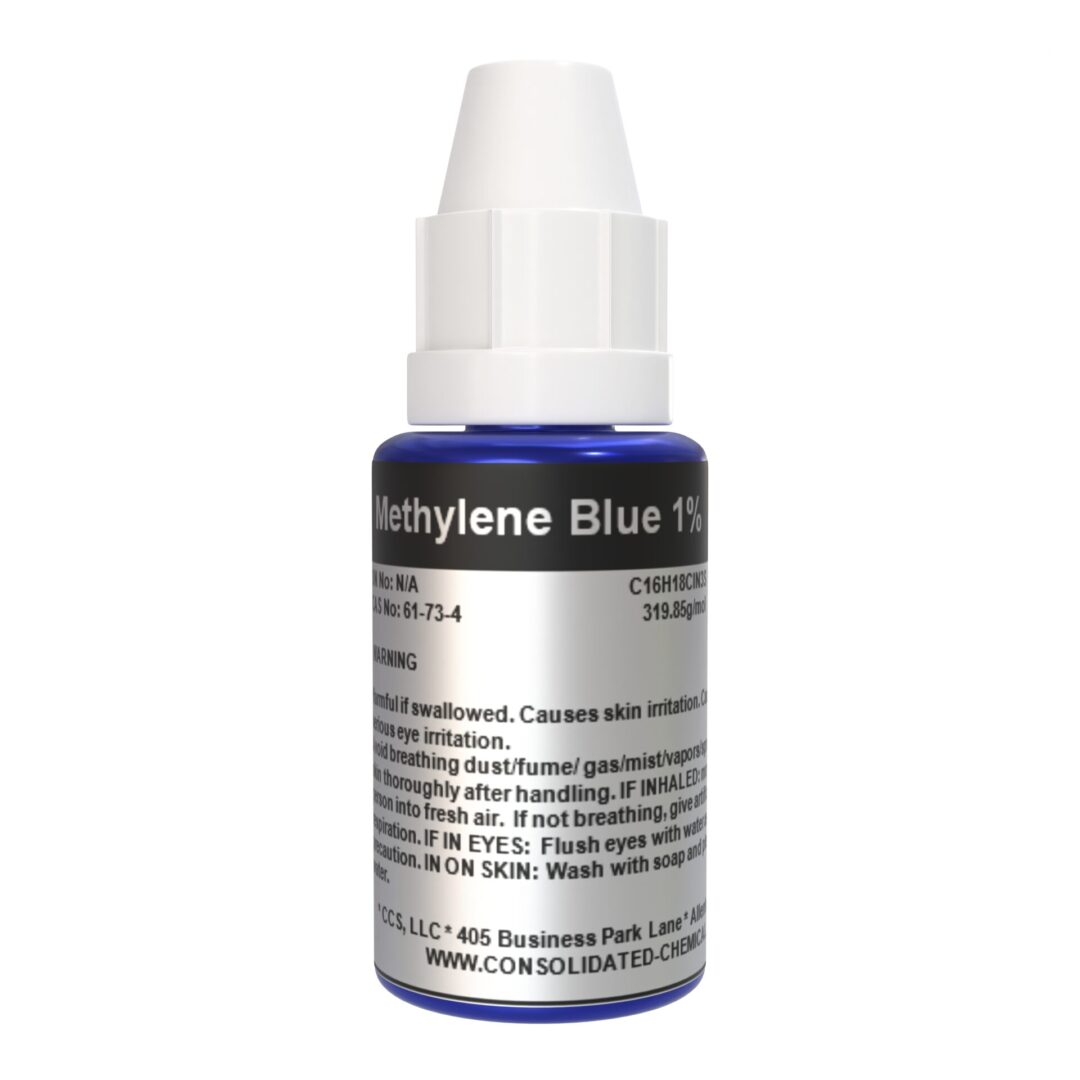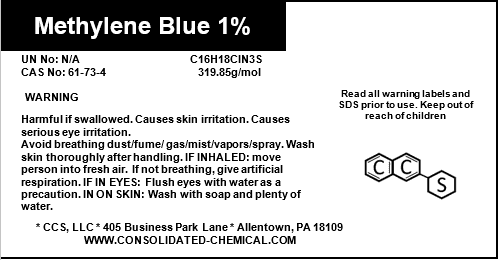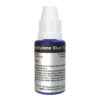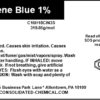Methylene Blue 1% Aqueous Stain/dye Solution
$12.00
Chemical Information:
- Chemical Name: Methylene Blue 1% Solution
- CAS Number: 61-73-4
- Molecular Formula: C₁₆H₁₈ClN₃S · xH₂O
- Molecular Weight: 319.85 g/mol (anhydrous form)
- Appearance: Deep blue liquid solution
- Odor: Odorless to mild chemical odor
- Purity: ≥99% (Methylene Blue powder) in aqueous solution
Physical & Chemical Properties:
- Concentration: 1% (10 g/L)
- Density: ~1.00 g/cm³
- Solubility:
- Completely soluble in water
- Partially soluble in ethanol and organic solvents
- Viscosity: Low
- pH (in aqueous solution): ~6.0 – 7.5
- Hydrolysis Degree: Not applicable
- Film-Forming Ability: Limited, primarily used as a staining and dyeing agent
- Biodegradability: Moderate, decomposes under environmental conditions
Mechanical & Stability Properties:
- Combustibility: Non-flammable, but may decompose at high temperatures
- Flash Point: Not applicable (water-based solution)
- Refractive Index: ~1.33 (similar to water)
- Tensile Strength: Not applicable (liquid form)
Documents:
Description
Methylene Blue 1% Aqueous Solution is a laboratory-grade dye commonly used as a biological stain for microscopic examination, particularly for highlighting cellular structures and identifying bacteria. Its strong, reliable staining properties make it ideal for various applications in biological research, clinical diagnostics, and educational settings. This ready-to-use solution provides convenience and consistency in laboratory protocols requiring a high-quality, aqueous methylene blue stain.
Applications of Methylene Blue 1% Aqueous Stain/Dye Solution
- Laboratory & Research Applications
- Used as a biological stain for microscopy and cell visualization.
- Essential in chemical reactions and oxidation-reduction studies.
- Applied in DNA and RNA gel electrophoresis staining.
- Microbiology & Bacterial Staining
- Used in bacterial staining for Gram-negative bacteria.
- Helps in blood smear staining and identifying cellular structures.
- Common in histology and tissue staining for medical diagnostics.
- Medical & Pharmaceutical Uses
- Investigated for antimicrobial, antifungal, and antiviral properties.
- Historically used in methemoglobinemia treatment and malaria research.
- Studied in Alzheimer’s disease and neuroprotection applications.
- Aquatic & Veterinary Medicine
- Used in aquarium treatments for fish diseases, including fungal and parasitic infections.
- Commonly applied in veterinary medicine for antiseptic treatments.
- Educational & Science Experiments
- Frequently used in high school and university biology and chemistry labs.
- Demonstrates redox reactions and electron transport chain studies.
- Used in STEM education for basic microbiological and histological studies.
- Water Quality Testing
- Utilized in environmental research to assess water contamination.
- Helps detect oxygen levels and oxidation potential in water bodies.
- Textile & Industrial Dyeing
- Used in textile dyeing for coloration in fabrics and materials.
- Applied in ink and pigment formulations for industrial use.
- Aromatherapy & Alternative Medicine Research
- Being explored in alternative health treatments and nootropic research.
- Found in certain holistic wellness and detox formulations.
Storage Instructions:
- Temperature: Store in a cool, dry place between 15-25°C (59-77°F) to maintain stability and prevent degradation.
- Sealing: Keep the container tightly closed to prevent evaporation and contamination.
- Light Exposure: Store away from direct sunlight and strong UV light to prevent photodegradation.
- Humidity Control: Avoid excessive moisture to maintain solution integrity.
- Compatibility: Keep away from strong acids, strong oxidizers, and reducing agents, as they may cause chemical instability.
Handling Precautions:
- Ventilation: Use in a well-ventilated area to minimize inhalation of vapors.
- Personal Protective Equipment (PPE):
- Wear gloves, safety goggles, and a lab coat when handling.
- Use a respirator or face mask if working in enclosed areas with high vapor exposure.
- Spill Management:
- Absorb small spills with paper towels, cloth, or inert material and dispose of properly.
- Avoid rinsing large amounts into drains—follow local disposal regulations.
- Hygiene:
- Wash hands thoroughly after handling.
- Avoid eating, drinking, or smoking while working with the product.
Safety Considerations:
- Combustibility: Non-flammable but may decompose at high temperatures. Avoid heat sources.
- First Aid Measures:
- Inhalation: Move to fresh air. Seek medical attention if breathing difficulties occur.
- Skin Contact: Wash with soap and water if irritation occurs.
- Eye Contact: Rinse immediately with water for at least 15 minutes and seek medical attention if necessary.
- Ingestion: Do not induce vomiting. Seek medical assistance immediately if swallowed in large amounts.
Additional information
| Size | 60mL (2 Fl Oz) |
|---|
Related products
-
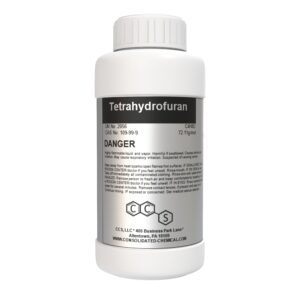
Tetrahydrofuran (THF) – Premium High Purity Solvent
$18.00 – $600.00 Select options This product has multiple variants. The options may be chosen on the product page -
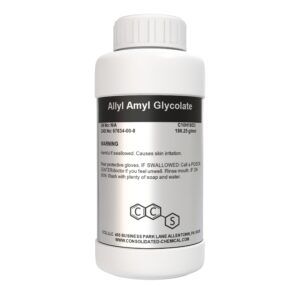
Allyl Amyl Glycolate | Premium Fragrance/Aroma Compound
$16.00 – $29.99 Select options This product has multiple variants. The options may be chosen on the product page -
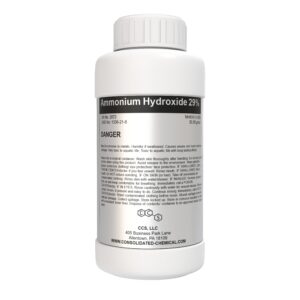
Ammonium Hydroxide 29% – Premium Aqueous Solution
$14.99 – $29.99 Select options This product has multiple variants. The options may be chosen on the product page -

Formaldehyde 37% Solution (Methanal) – Lab Grade
$23.99 – $320.00 Select options This product has multiple variants. The options may be chosen on the product page
SKU: N/A
Categories: Dyes (2), Industrial Chemical
Tags: Aqueous Stain, Bacteriological Stain, basic blue 9, Biological Stain, Blood Smear Stain, Buy Methylene Blue 1% Solution, Buy Methylene Blue in Bulk, CAS 61-73-4, Cell Staining Solution, Cell Viability Stain, Diagnostic Stain, Educational Lab Stain, Hematology Stain, High Purity Methylene Blue 1%, High-Purity Methylene Blue, Histology Dye, indicator, Laboratory Dye, Laboratory Grade Stain, methylene, Methylene Blue 1%, Methylene Blue 1% Aqueous Solution, Methylene Blue 1% Bulk, Methylene Blue 1% Dye, Methylene Blue 1% for Sale, Methylene Blue 1% Manufacturer, Methylene Blue 1% Online, Methylene Blue 1% Solution, Methylene Blue 1% Stain, Methylene Blue 1% Supplier, Methylene Blue 1% Wholesale, Methylene Blue Best Price, Methylene Blue Biological Stain, Methylene Blue Chemical Properties, Methylene Blue Eco-Friendly, Methylene Blue Food Grade (Regulated Use), Methylene Blue for Advanced Science, Methylene Blue for Algae Control, Methylene Blue for Anti-Malaria Research, Methylene Blue for Antibacterial Use, Methylene Blue for Antifungal Use, Methylene Blue for Antimicrobial Use, Methylene Blue for Antiseptic Applications, Methylene Blue for Aquarium Use, Methylene Blue for Aquatic Science, Methylene Blue for Aquatic Treatments, Methylene Blue for Bacterial Culture Media, Methylene Blue for Bacterial Staining, Methylene Blue for Bioassays, Methylene Blue for Biochemical Engineering, Methylene Blue for Biochemistry, Methylene Blue for Biological Research, Methylene Blue for Biomedical Research, Methylene Blue for Biotech Applications, Methylene Blue for Blood Smears, Methylene Blue for Cell Biology, Methylene Blue for Cell Culture, Methylene Blue for Cell Staining, Methylene Blue for Chemical Industry, Methylene Blue for Chemical Reactions, Methylene Blue for Chemistry Labs, Methylene Blue for Chromatography, Methylene Blue for Diagnostic Applications, Methylene Blue for Disinfectant Formulations, Methylene Blue for Disinfection, Methylene Blue for DNA Staining, Methylene Blue for Educational Use, Methylene Blue for Electron Microscopy, Methylene Blue for Electrophoresis, Methylene Blue for Environmental Studies, Methylene Blue for Fish Tanks, Methylene Blue for Fungal Identification, Methylene Blue for Genetic Research, Methylene Blue for Gram Staining, Methylene Blue for Hematology, Methylene Blue for Histology, Methylene Blue for Immunology, Methylene Blue for Industrial Applications, Methylene Blue for Industrial Dyeing, Methylene Blue for Laboratory Experiments, Methylene Blue for Laboratory Research, Methylene Blue for Medical Labs, Methylene Blue for Medical Treatments, Methylene Blue for Microbial Growth Studies, Methylene Blue for Microbiology, Methylene Blue for Molecular Biology, Methylene Blue for Nucleic Acid Staining, Methylene Blue for Oxidation-Reduction Reactions, Methylene Blue for Parasitology, Methylene Blue for Pathology Labs, Methylene Blue for pH Indicator, Methylene Blue for Pharmaceuticals, Methylene Blue for Physics Labs, Methylene Blue for Protein Staining, Methylene Blue for Redox Indicators, Methylene Blue for Research Institutions, Methylene Blue for School Labs, Methylene Blue for School Science Kits, Methylene Blue for Science Experiments, Methylene Blue for Scientific Kits, Methylene Blue for Scientific Research, Methylene Blue for Skin Treatments, Methylene Blue for Spectrophotometry, Methylene Blue for Spectroscopy, Methylene Blue for STEM Education, Methylene Blue for Textile Dyeing, Methylene Blue for Tissue Staining, Methylene Blue for Toxicology Studies, Methylene Blue for University Labs, Methylene Blue for Veterinary Use, Methylene Blue for Water Filtration, Methylene Blue for Water Purification Research, Methylene Blue for Water Testing, Methylene Blue for Yeast Metabolism Studies, Methylene Blue for Yeast Staining, Methylene Blue Handling Precautions, Methylene Blue High Stability, Methylene Blue in Analytical Chemistry, Methylene Blue Industrial Grade, Methylene Blue Laboratory Grade, Methylene Blue Laboratory Stain, Methylene Blue Light Sensitivity, Methylene Blue Market Price, Methylene Blue Medical Grade, Methylene Blue Microscopy Stain, Methylene Blue MSDS, Methylene Blue Pharmaceutical Grade, Methylene Blue Safety Data Sheet, Methylene Blue Shelf Life, Methylene Blue Staining Solution, Methylene Blue Storage, Methylene Blue Supplier Near Me, Methylene Blue Sustainable, Methylene Blue Water Solubility, Microbiology Stain, Microscope Slide Stain, Microscopy Dye, Order Methylene Blue Online, Premium Quality Methylene Blue 1%, Ready-to-Use Stain, slides, stain, Tissue Staining Solution, Vital Stain, Where to Buy Methylene Blue


